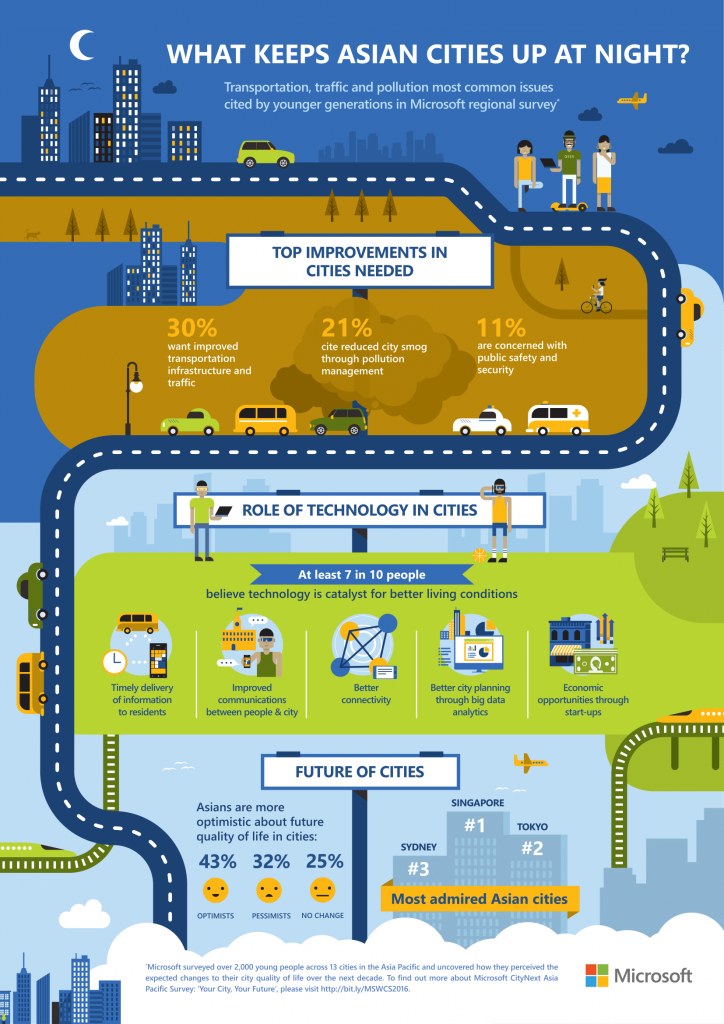Amid rising urbanization pressures, effective provision of information to residents enabled by technology is seen as most significant catalyst in improving city living conditions
SINGAPORE –11 JULY 2016 – Microsoft today released findings from the Microsoft CityNext Asia Pacific Survey: Your City, Your Future, which polled over 2,000 residents from 13 cities in the region on their outlook and priorities over the next decade amid rising urbanization pressures. The cities polled comprised: Bangkok, Beijing, Shanghai, Delhi, Mumbai, Jakarta, Manila, Seoul, Singapore, Sydney, Taipei, Tokyo, and Osaka.
While urban residents in the region are generally optimistic about their future quality of life, there are still areas of improvement they would like to see. In order of priority, they ranked their top concerns: Transportation infrastructure and traffic conditions; pollution; cost of living; public safety and security; and employment opportunities.
In terms of bright spots, respondents felt that technology plays a key role in improving their city quality of life, with its biggest impact through the delivery of information to residents (80 percent). This was followed by improving communications between the people and the city (79 percent), better connectivity eg. Wi-Fi and mobile (77 percent), big data analytics to enable better city planning (77 percent), and new economic opportunities eg. through startups (72 percent);
The Asia Pacific region is home to over half of the world’s urban population, according to the United Nations. By 2050, the urban population in the Asia Pacific region is predicted to increase by over 60 percent and more than half of the urban population of the world will be concentrated in Asia. On top of this, the region will also need to grapple with its ageing populations – by 2050, Asia Pacific will host nearly two-thirds of the world’s older population, although by then only about half of the world’s total population is living in the region.
Stefan Sjöström, Vice President, Public Sector, Microsoft Asia said, “We are facing daunting issues as the march towards urbanization unleashes a new wave of challenges, for both developed and developing Asian economies. Cities face extreme pressure to modernize aging infrastructure and provide more services to citizens while coping with economic austerity and dwindling financial resources.”
“From cloud-based solutions to mobile applications to big data, technology is playing a big role in transforming cities into smart communities that are safer, smarter, and more sustainable. For instance, governments especially in the Asia Pacific region all grapple with urban challenges like traffic congestion. Technology solutions allow city officials and businesses to take advantage of big data technology and existing assets – including data and devices – to transform transportation infrastructure, improve traffic and reduce costs,” added Sjöström.
Most admired Asia Pacific city
Across the 13 cities polled, more people felt optimistic about their future living conditions with 43 percent expecting improvements in their quality of life compared with 32 percent who feel more pessimistic.
Residents of developed economies were relatively much more likely to be pessimistic about maintaining their quality of life than residents of Asia’s less affluent cities. The study attributed factors toward this including a limited scope of further improvements in their quality of life, a cultural bias in responses as well as a prediction of a deterioration in their quality of life.
Nevertheless, such developed countries appear to be the object of admiration by other Asia Pacific cities with one in four respondents citing Singapore as the city that they would most like to live in, outside of their home country. This was followed by Tokyo, Sydney and Melbourne. The top factors which determine people’s preferences for cities other their own are: Cleanliness and a green environment (28 percent); exciting, modern and advanced city living (14 percent), and beautiful and well-laid city (14 percent).
| 1. Singapore
2. Tokyo 3. Sydney 4. Melbourne 5. Osaka 6. Hong Kong |
7. Seoul
8. Taipei 9. Bangkok 10. Kuala Lumpur 11. Shanghai 12. Ho Chi Minh City |
13. Beijing
14. Jakarta 15. Manila 16. Mumbai 17. Delhi 18. Others |





